
Key Takeaways
Private equity (PE) investing has traditionally been dominated by large institutions, but is gaining ground within individual investor portfolios through the secondary market.
Investing in PE secondaries involves buying interests in a PE fund from an existing investor, typically after the fund’s investment period.
Potential benefits of investing in a PE secondaries fund include diversification against traditional stock and fixed income investments; faster returns than investing in primary PE; better transparency; and discounted buying opportunities.
Individual investors can now access the formerly exclusive club of private equity through registered investment vehicles that focus on secondary investments, allowing for greater flexibility and potentially accelerated cash flow.
PE: From exclusive to inclusive
For every Amazon or Apple traded on public stock exchanges, there are a thousand privately held businesses seeking investor capital to grow. 7.9 million private incorporated businesses currently operate in the United States—one-quarter of which employ at least 50 workers (Exhibit 1). Private companies represent every major industry, from technology manufacturing to retail, including some of the fastest-growing and most disruptive start-ups. Yet many investors avoid exploring this asset class because it seems inaccessible and complicated.
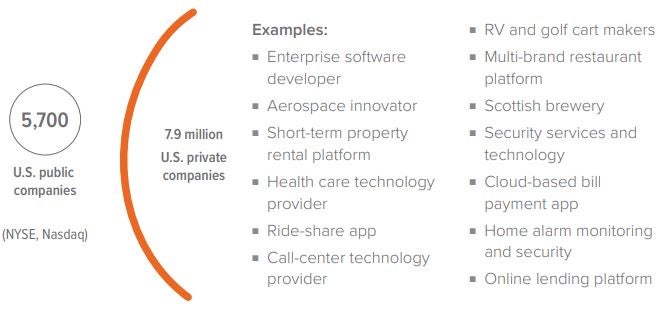
As of 09/30/24. Source: Statista, Kaiser Family Foundation, Pomona Capital. Estimated number of companies based on most recent common available data. Public companies: Statista, “NYSE and Nasdaq: Listed companies comparison, 2023,” 05/17/24. Private companies: Kaiser Family Foundation (kff.org), Number of Private Sector Firms by Size, 2023. Private company/industry examples: Pomona Capital.
It’s true that PE has historically been an exclusive club for large institutional investors, such as pension funds, sovereign wealth funds and insurance companies along with family offices and certain ultra-high-net-worth investors.
However, the emergence of new investment vehicles has opened the market to a wider range of investors. Some of these investment solutions address hurdles that previously have discouraged broader adoption by reducing investment minimums, simplifying tax filings, and offering regular liquidity opportunities.
What’s changed? The answer is in the growing access to PE interests. For accredited investors who have been appropriately advised, PE secondaries may offer an attractive way to enhance a well-diversified portfolio.
What is PE?
When a privately owned company wants to grow its operations, it may seek funding from a PE management firm in exchange for a stake in future profits. This approach may offer an attractive alternative to conventional forms of financing, such as taking out a loan (which can be expensive) or listing shares on a public stock exchange (which may not be feasible).
The PE fund manager (also called a general partner, or GP) raises capital from investors—known as limited partners (LPs)—pooling the funds with its own capital into a fund that invests in a diversified portfolio on behalf of the LPs (Exhibit 2). Portfolio assets typically consist of the equity of private companies, but may also include debt investments, commercial real estate and infrastructure projects such as solar farms, transportation systems or water treatment plants.
GPs may bring expertise and resources to the companies in their portfolios. By working with company management teams, the GP may seek to enhance the equity value of its investments in several ways.
- Accelerating revenue growth. The GP and management team may drive additional revenues by launching new products, expanding to new markets, increasing sales efforts and making acquisitions
- Enhancing profit margins. Cost savings may be achieved by focusing on higher-margin products, leveraging economies of scale and fine-tuning product pricing
- Improving the capital structure. As a company generates cashflow, it may be able to reduce its debt over time, decreasing its financial risk
- Upgrading operations. A GP may help the company improve its management, market strategy and operating model, potentially increasing the value of the enterprise
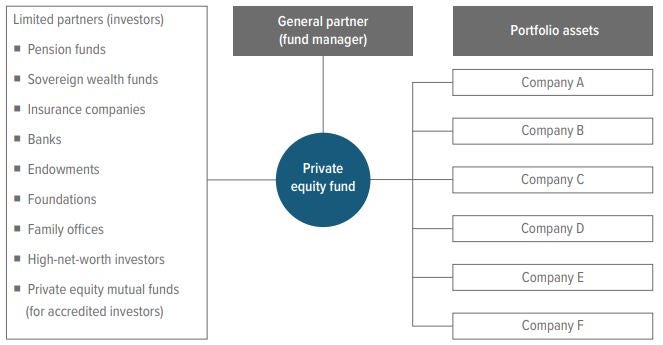
Source: Pomona Capital.
As with any investment, PE involves risk, and success isn’t guaranteed. However, top PE fund managers tend to have a strong track record of improving the economic performance of the companies in their portfolios. Historically, differences in manager skill and a fund’s investment strategy, geographic concentration and industry focus have resulted in a wide dispersion of performance among PE funds relative to public market funds (Exhibit 3). As a result, the ability to research and access the right managers may be critical to an investor’s experience in PE.
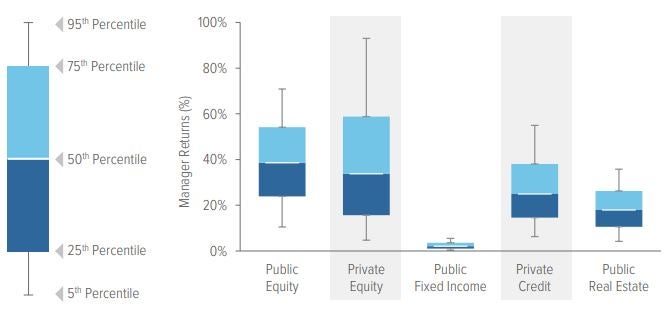
As of 12/31/23. Source: Morningstar® (public fund data; returns shown over a five-year period from 01/01/19 through 12/31/23), Pitchbook (private fund data for 2019 vintages of North American closed funds as of 12/31/23), Pomona Capital. Each asset class shown is represented by Morningstar® Fund Categories as follows: Public equity: U.S. Large Blend. Public fixed income: U.S. Intermediate Core Bonds. Public real estate: U.S. Real Estate. Private equity: Buyout, Diversified & Growth/Expansion funds. Private credit: All Private Debt strategies. Past performance is no guarantee of future results, and the possibility of loss does exist. Investments in less liquid private market strategies are by nature risky and typically involve a high degree of leverage. The returns indicated above are long-term and represent well-known asset class indexes and are not meant to be predictive of the performance of any particular fund, nor are they meant to suggest that all private funds result in positive returns or would avoid loss of principal.
PE is a long-term investment
Investments in the private markets have key differences from those in publicly traded equities. Unlike the real-time auction-based pricing of the New York Stock Exchange or the Nasdaq, the value of private companies is calculated infrequently, usually on a quarterly basis. Moreover, the long-term nature of PE investing means that capital is often locked up for the life of the fund.
A typical PE fund is structured with a finite life span of about 10 years, which may be extended if needed, subject to approval by the LPs.

Private companies often require additional capital throughout their lifecycle, offering investors multiple opportunities for investment. During this time, PE managers may employ a range of strategies to realize value (Exhibit 4). The most established are buyouts of private companies or divisions of larger companies for development and eventual sale. By contrast, venture capital tends to involve higher risk, targeting start-ups and early-stage growth companies.
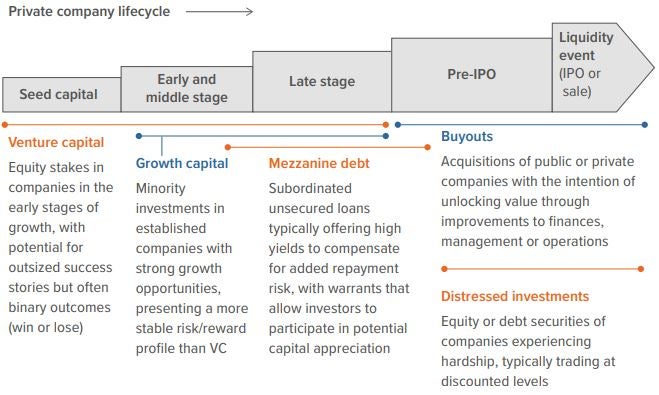
Source: Pomona Capital. The descriptions above represent the views and opinions of Pomona Capital.
Secondary market investing: Accelerating the curve
PE secondaries provide access to institutional PE with greater flexibility and potentially accelerated cashflow for the end investor. When an LP wants to make an early exit, they can sell their interests in a fund to other investors through the secondary market. This transaction provides liquidity to the primary investor and potentially compelling benefits to incoming investors.
Limiting the J-curve drag
A secondary investment transaction typically takes place after a PE fund has invested a significant portion of its capital (generally three to seven years into its lifecycle). One potential benefit of this approach is that a secondary investment may limit the impact of the J-curve, named for the shape of the intended pathway of returns (Exhibit 5). That’s because early in the fund’s lifecycle, the GP makes investments that often see little or no growth for several years, while the fund continues to incur expenses. As portfolio companies grow, the sale or refinancing of these companies may generate cash distributions on top of any unrealized gains reflected in the fund’s net asset value.
Faster distributions and exits
A related benefit to J-curve mitigation is that secondary investors are entering closer to the period when distributions may begin to LPs as fund investments generate positive cashflow. Investors are also closer to the end of a fund’s life, when remaining assets are liquidated and any gains (or losses) are realized.
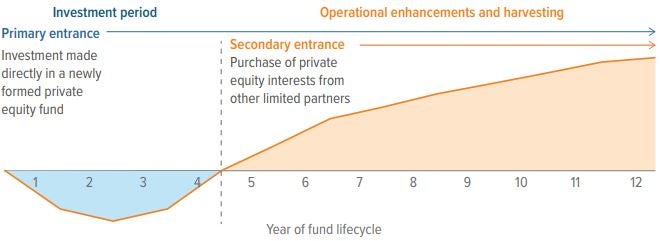
Source: Pomona Capital. This chart is for illustrative purposes and does not represent past or projected performance of an actual product. There is no guarantee performance will match this illustration. There is no guarantee that there will be any cash flow earned from the investment given the risks of investing in private equity. Technically, a secondary investment may occur at any time during the life of a fund. Investments in private equity involve risk, and an investor may lose some or all their investment. The descriptions above represent the views and opinions of Pomona Capital.
Transparency
After a few years, most funds will have already invested a large portion of the capital committed by investors. Whereas primary investors commit capital to a blind pool, in which investments have yet to be made, secondary investors can assess each asset in the portfolio and make their own determination of value.
Discounted pricing
To entice secondary buyers to acquire their fund interests today, primary investors may sell their ownership interest at a discount to the present value of the underlying assets, recognizing that the buyer takes on the risk of waiting for potential realizations from the fund’s investment in the future. Well-resourced fund managers may exploit the many anomalies in this market to identify and capitalize on value opportunities.
Institutional PE wrapped in a mutual fund
Many investors associate PE with obstacles that may have discouraged participation in the past. An attractive alternative to a traditional PE fund is a registered investment vehicle that targets PE assets, including secondary and primary investments, as well as direct and co-investment opportunities. Typically offered to accredited investors, these funds provide potential advantages over a traditional PE fund.
Investing in PE doesn’t have to be complicated. Talk to your financial advisor to see if a registered PE secondaries fund may be a suitable addition to your portfolio.
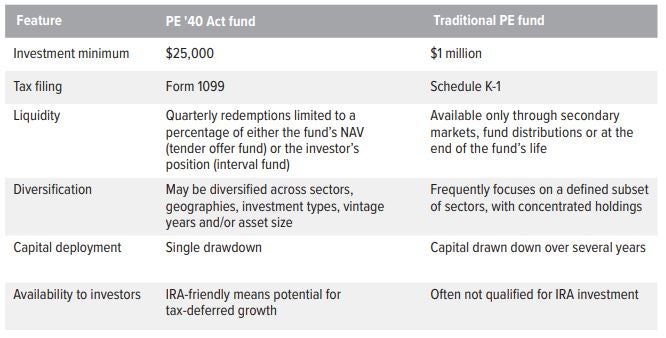
Investing with Voya and Pomona Capital
Founded in 1994, Pomona Capital has been a fully owned subsidiary of Voya Investment Management since 2000.
Our secondaries-focused strategy—complemented by primary funds and coinvestment— seeks to identify assets with above-average quality, near-term liquidity and below-market prices. It provides eligible accredited investors access to many of the same funds and opportunities typically reserved for the world’s largest institutional investors.
Our global team of 50+ private equity professionals conducts granular analysis of potential investments, led by a senior investment team with more than 12 years of experience on average. Relationships with more than 600 private equity funds provide a large pool for identifying potential opportunities.
A note about risk
There are no guarantees a diversified portfolio will outperform a non-diversified portfolio. Diversification does not guarantee a profit or ensure against a loss. Past performance is no guarantee of future results.
Private equity may not be suitable for every investor, may involve a high degree of risk, and may be appropriate investments only for sophisticated investors who are capable of understanding and assuming the risks involved.
All investments in bonds are subject to market risks. Bonds have fixed principal and return if held to maturity, but may fluctuate in the interim. Generally, when interest rates rise, bond prices fall. Bonds with longer maturities tend to be more sensitive to changes in interest rates.
All equity investing involves risks of fluctuating prices and the uncertainties of rates of return and yield inherent in investing. Foreign investing does pose special risks including currency fluctuation, economic and political risks not found in investments that are solely domestic. Emerging market stocks may be especially volatile. Stock of an issuer in the Fund’s portfolio may decline in price if the issuer fails to make anticipated dividend payments because, among other reasons, the issuer of the security experiences a decline in its financial condition. Securities of small- and mid-sized companies may entail greater price volatility and less liquidity than investing in stocks of larger companies. Private equity investments are subject to various risks. These risks are generally related to: (i) the ability of the manager to select and manage successful investment opportunities; (ii) the quality of the management of each company in which a private equity fund invests; (iii) the ability of a private equity fund to liquidate its investments; and (iv) general economic conditions. Private equity funds that focus on buyouts have generally been dependent on the availability of debt or equity financing to fund the acquisitions of their investments. Depending on market conditions, however, the availability of such financing may be reduced dramatically, limiting the ability of such private equity funds to obtain the required financing or reducing their expected rate of return.
Private equity funds as well as securities that invest in such funds and companies in which such funds or securities may invest tend to lack the liquidity associated with the securities of publicly traded companies and as a result are inherently more speculative.
